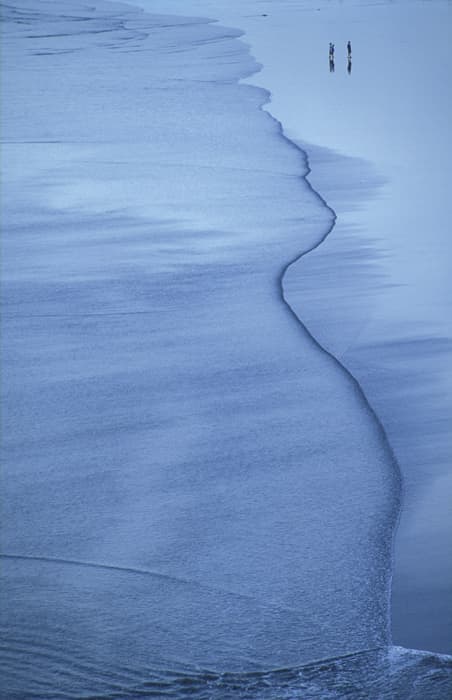Photo Insight with David Noton

One of the foremost travel and landscape photographers working today, David Noton tirelessly travels the world in search of new challenges, which he shares with you here
Muriwai is a long beach on the North Island of New Zealand. It’s famous for its gannet colony, and this was the reason I was there. However, looking around and exploring the area presented a number of other compositional opportunities. Obviously, you need a plan when you embark on a shoot, but at the same time you need to keep an eye out for photographic opportunities that may reveal themselves as you’re shooting. In other words, whenever you’re on a shoot, always consider alternative subjects you could explore. This was one of those impromptu moments. When I saw the waves breaking on the beach and the wet sand reflecting the cool blue light, I knew I had to explore further.
I took this image in the evening and the blue colour cast is due to the lack of sun, which had fallen below the horizon. However, there was still enough light in the sky for me to make an exposure, and while there is only one colour in the scene it’s fairly muted. There is a time and a place to create monochromatic images and this was one of them. In AP 20 August, I explained how I took my image of a poppy field near St-Rémy-de-Provence in southern France where smatterings of brilliant reds and greens burst out of the frame. The Muriwai beach scene, with its subtle use of colour, is completely the opposite, but it shows how monochromatic colour can be just as powerful as an explosion of many vibrant colours.
Apart from the abstract shapes created by the wiggly line that cuts through the centre of the frame, there isn’t a lot else to the composition – and I don’t mean that in a negative way. This image works because it has an inherent simplicity. The two tiny figures at the top of the frame provide a point of reference and a sense of scale. Shooting with the camera in portrait format really accentuates the pencil-like line running through the composition.

I’m standing on a headland looking down along the sweep of the beach below. In a way, it’s not immediately obvious what it is you’re looking at. The image is slightly disorientating. It’s sometimes fun to create pictures that make the viewer stop and think, and question what they’re looking at. It looks like a deserted, lonely scene, but there were actually quite a few people around. Through careful framing and positioning of the individual elements in the frame, I’ve been able to create this feel.
The slightly rough textures in the water are also interesting, and they give the image an almost painterly, watercolour quality. I also like the wet sand in the top right-hand part of the picture, which looks like a mirror. While I never set out and think, ‘I must make sure I include interesting textures in my image,’ if I see textures that I feel could add something I’ll try to incorporate them into the composition. There are a lot of landscape images of water where the photographer has used a long exposure to create a milky effect. While this can be interesting, I quite often like to see the textures, shapes and form of the water.
I took this image some time ago when I was using film. I used a Nikon F5 camera loaded with Fujichrome Velvia 35mm film and a 70-200mm lens. If I had been shooting this scene digitally I would have used the daylight white balance setting. When shooting digitally, I very rarely change the white balance either in-camera or afterwards when I’m processing my image. If the colour temperature of the light is cool I’ll go with it, as it is part of what I’m seeing in front of me. Using the auto white balance setting tends to cause the camera to ‘correct’ the colour temperature, which isn’t necessarily the look I’m after.
While I hadn’t forgotten about this photograph I hadn’t looked at it for some time. Examining an image after a period of time is always interesting because, in a way, you rediscover it. I find it amazing that I can look at something I took many years ago and remember the lens I used, what it was like being there at the time and so on. Every image is such a huge investment of time and energy that it becomes part of who you are.
 David Noton’s book Full Frame, priced £25 and published by David & Charles, is now available. It follows David’s journey to ten different locations around the world and gives invaluable insight into his approach and working methods. To see more images by David visit www.davidnoton.com
David Noton’s book Full Frame, priced £25 and published by David & Charles, is now available. It follows David’s journey to ten different locations around the world and gives invaluable insight into his approach and working methods. To see more images by David visit www.davidnoton.com








